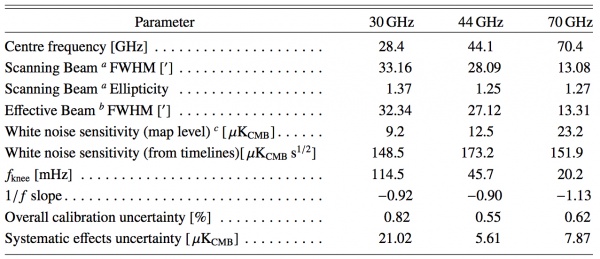Difference between revisions of "Summary LFI"
| (9 intermediate revisions by 2 users not shown) | |||
| Line 1: | Line 1: | ||
| − | The LFI performance are summarized in Table 1 below. All the details can be found in the LFI data processing paper | + | {{DISPLAYTITLE:Summary of LFI data characteristics}} |
| + | The LFI performance are summarized in Table 1 below. All the details can be found in the LFI data processing paper {{PlanckPapers|planck2013-p02}}. | ||
| + | |||
| + | <center> | ||
| + | '''Table 1. Summary of the LFI performance parameters''' | ||
| + | [[File:tab_perf2.jpg|thumb|center|600px| | ||
| + | <math>^{ \rm a \, }</math> FWHM and ellipticity from scanning beam evaluated fitting Jupiter directly in the timelines. <math>\hspace{480mm} </math> | ||
| + | <math>^{ \rm b \, }</math> FWHM from effective beam estimated from the main beam solid angle of the effective beam. Those are the values used in the source extraction pipeline {{PlanckPapers|planck2013-p05}}. | ||
| + | <math>\hspace{70mm} </math> | ||
| + | <math>^{ \rm c \, }</math> White noise per pixel computed from half-ring difference maps. Those values are within the 1% with the white noise sensitivity computed directly on the timelines, taking in account the actual mission time minus the manoeuvres and bad-science flagged data. | ||
| + | ]] | ||
| + | </center> | ||
| + | |||
| + | <!-- | ||
<center> | <center> | ||
| − | Table 1. Summary of the LFI performance parameters | + | '''Table 1. Summary of the LFI performance parameters''' |
[[File:Lfi_perf.jpg|thumb|center|655px|<math>^{ \rm a \, }</math> White noise per pixel computed from half-ring difference maps. Those values are within the 1% with the withe noise sensitivity computed directly on the timelines, taking in account the actual mission time minus the manoeuvres and bad-science flagged data | [[File:Lfi_perf.jpg|thumb|center|655px|<math>^{ \rm a \, }</math> White noise per pixel computed from half-ring difference maps. Those values are within the 1% with the withe noise sensitivity computed directly on the timelines, taking in account the actual mission time minus the manoeuvres and bad-science flagged data | ||
<math>^{ \rm b \, }</math> FWHM and ellipticity from scanning beam evaluated fitting Jupiter directly in the timelines. <math>\hspace{50mm} </math> | <math>^{ \rm b \, }</math> FWHM and ellipticity from scanning beam evaluated fitting Jupiter directly in the timelines. <math>\hspace{50mm} </math> | ||
<math>^{ \rm c \, }</math> FWHM and ellipticity from effective beam evaluated as mean from different position on the sky. <math>\hspace{42mm} </math> | <math>^{ \rm c \, }</math> FWHM and ellipticity from effective beam evaluated as mean from different position on the sky. <math>\hspace{42mm} </math> | ||
| − | <math>^{ \rm d \, }</math> FWHM from effective beam evaluated as FWHM<math>_{eff} = \sqrt{\frac{Ω}{2π}} · 2 · \sqrt{2 \log 2}</math>, where Ω is the mean beam solid angle of the effective beam. Those are the values used in the source extraction pipeline | + | <math>^{ \rm d \, }</math> FWHM from effective beam evaluated as FWHM<math>_{eff} = \sqrt{\frac{Ω}{2π}} · 2 · \sqrt{2 \log 2}</math>, where Ω is the mean beam solid angle of the effective beam. Those are the values used in the source extraction pipeline {{PlanckPapers|planck2013-p05}}. |
]] | ]] | ||
</center> | </center> | ||
| + | --> | ||
== References == | == References == | ||
| − | < | + | <References /> |
| − | + | ||
| − | + | ||
| − | [[Category: | + | [[Category:LFI data processing|009]] |
Latest revision as of 16:20, 23 July 2014
The LFI performance are summarized in Table 1 below. All the details can be found in the LFI data processing paper Planck-2013-II[1].
Table 1. Summary of the LFI performance parameters

FWHM and ellipticity from scanning beam evaluated fitting Jupiter directly in the timelines. FWHM from effective beam estimated from the main beam solid angle of the effective beam. Those are the values used in the source extraction pipeline Planck-2013-XXVIII[2]. White noise per pixel computed from half-ring difference maps. Those values are within the 1% with the white noise sensitivity computed directly on the timelines, taking in account the actual mission time minus the manoeuvres and bad-science flagged data.
References[edit]
- Jump up ↑ Planck 2013 results: The Low Frequency Instrument data processing, Planck Collaboration 2013 II, A&A, in press, (2014).
- Jump up ↑ Planck 2013 results: The Planck Catalogue of Compact Sources, Planck Collaboration XXVIII, A&A, in press, (2014).
(Planck) Low Frequency Instrument
Full-Width-at-Half-Maximum